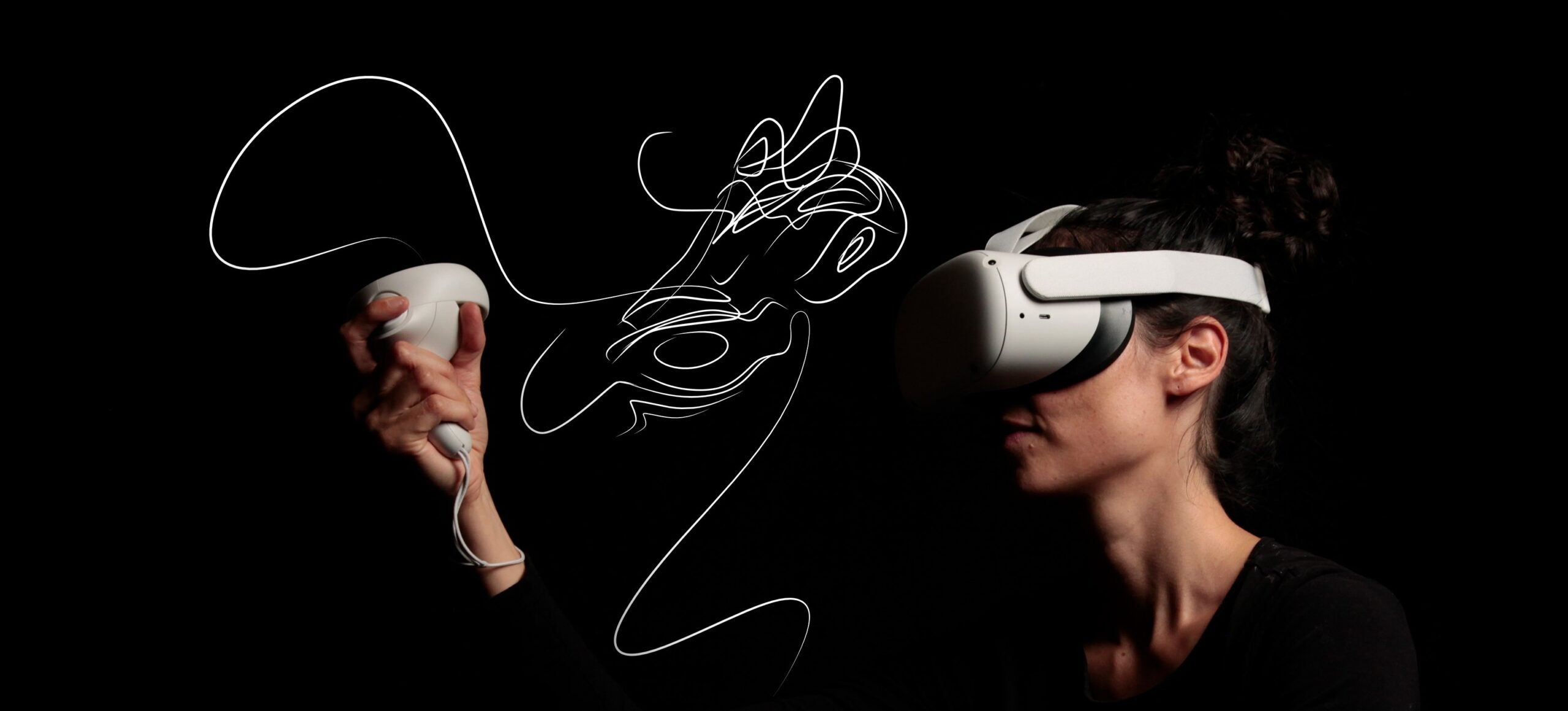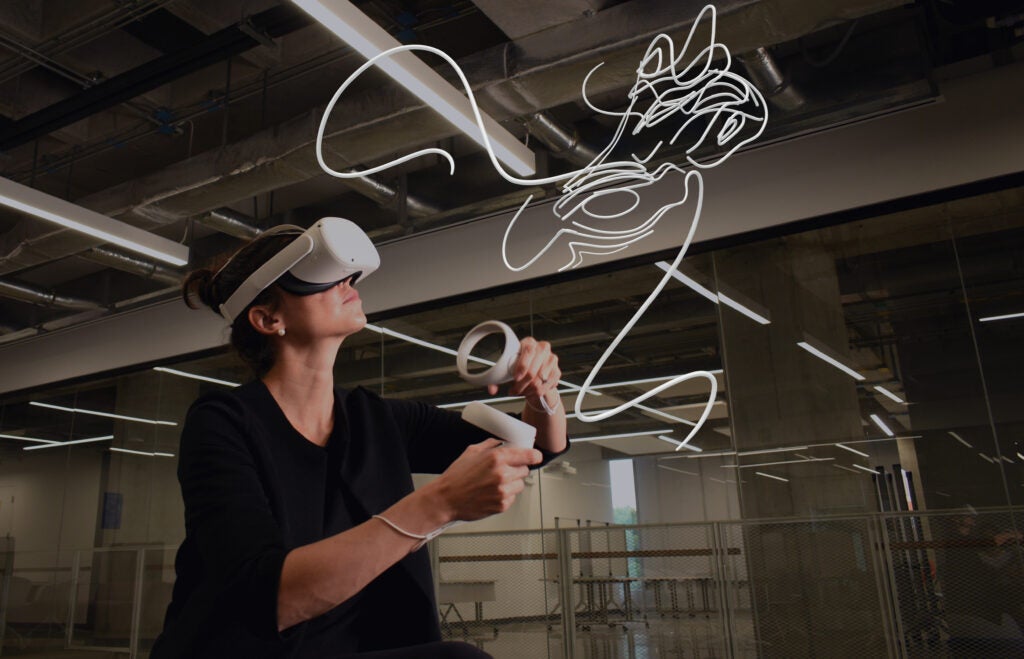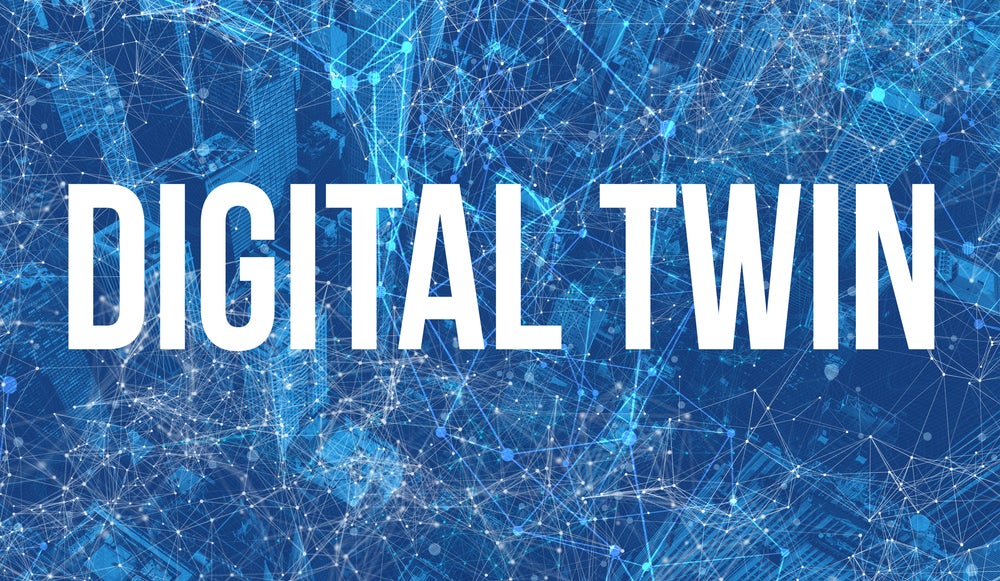
When it comes to making predictions about augmented reality (AR) and virtual reality (VR) in 2022, it’s not all about the metaverse: but a lot of it is.
Facebook’s recent rebrand as Meta has seen the popularity of the metaverse idea explode – or at least mentions of it. Suddenly it seems as if every other company wants to rebrand itself as a metaverse business. However, those already active in AR and VR technologies can do so with more credibility than others.
And it’s not all hype. In fact, when it comes to expert AR and VR predictions, GlobalData analysts believe the technology could be as revolutionary as the iPhone was back in 2007.
“Ultimately, AR technology may replace the smartphone as the primary connected device users carry around,” GlobalData researchers wrote in a recent report. “Moreover, AR will be a critical component of the metaverse – the next mega-theme that Big Tech has in its sights.”
AR and VR predictions from across the industry for 2022
This could be just the beginning. While the AR market was worth a fairly restrained $7bn in 2020, GlobalData estimates that it will generate revenues of $152bn by 2030. AR and VR firms are ready to play a big role in the future of companies, people and the world.
To find out how, Verdict asked industry stakeholders, analysts and experts to share their biggest AR and VR predictions for 2022. As it turns out, their predictions for where the AR and VR industries will go next involve more than just the metaverse. These technologies could be poised to have a massive impact on flexible working, diversity, fitness and proptech (property technology). Here’s what they told us:

Mark Rabkin, VP of VR, Meta
Remote work lets us work from nearly anywhere, but with that flexibility also comes new challenges. Some people struggle with feelings of isolation from co-workers, or difficulty focusing in distracting home environments. That’s where VR has superpowers: It lets people feel like they’re really together so they can build vivid memories of sharing a space and conversation. Those conversations flow much more fluidly with all the important body language cues, and with audio that gives you a sense of direction when someone speaks. And without physical limitations, VR brings infinite space for displays, persistent whiteboards, and easily expandable rooms.
So whether it’s to brainstorm, work on a document, or just hang out and socialise with your team, VR will aid people’s ability to collaborate, communicate, and connect remotely. In 2022, VR devices will get even more comfortable for longer wear, offer advanced optics for increased text clarity, and will enable avatars to mirror your real expressions – so you can be yourself at work. This is also the year VR will begin to connect more seamlessly with your existing workflows, including commonly used business tools, 2D services, and peripheral devices like keyboards. It will be inevitable that companies begin to normalise VR in addition to tools like laptops, tablets and phones. It’s the best way to create a shared sense of space and connection among dispersed workforces.

Daniela Paredes Fuentes, co-founder and CXO, Gravity Sketch
One of the biggest trends in the AR and VR space in 2022 will be the use of immersive technology and VR in the workplace. Tools like Zoom and Miro provide 2D ways of working together but with hybrid working becoming commonplace, organisations want to connect employees in intuitive and immersive ways that can only be achieved through VR. Spatial collaboration is very important, particularly in industries that work around products that will become physical goods.
Being able to work in the metaverse and adopt 3D tools to communicate ideas will also support a greater level of diversity and inclusion within organisations and this will be a major trend over the next few years. For businesses in 2022, adopting pioneering technology like Gravity Sketch, which enables cross-disciplinary teams to meet inside a virtual studio to create and collaborate from anywhere in the world, will be key to achieving this. Technology like this also helps to attract new talent in an increasingly competitive job market.
3D literacy is key to the future of science, creativity and entertainment but the barrier to entry needs to be lowered in 2022. Complex and expensive courses and tools mean only the privileged have the opportunity to work in industries such as design, but 2022 will see this start to change as companies strive to make their tools more accessible and organisations realise the need for a more diverse workforce.
Sustainability will be the third key trend in the AR and VR space in the coming year. As organisations are increasingly aware of their carbon footprint, many will be looking for innovative technology which will help in their efforts to reach net zero goals. AR and VR provide an ideal solution for this, removing the need for travel as teams can be together virtually, reducing sampling waste and shortening production times. Companies such as Ford, Adidas and Volkswagen have already realised this and begun adopting VR within their processes.
Jon Arnold, VP Sales, EMEA at RealWear
For businesses, AR and VR have gotten the spotlight as the next great leap in boosting worker productivity. But AR and VR technologies aren’t generally practical in safety critical environments like the industrial frontline.
Assisted reality is another emerging technology that balances the physical world with the digital one, giving users hands-free access to the right information when they need it, whilst allowing for full situational awareness. Given all the buzz about the metaverse, we believe industrial customers will lean toward assisted reality, and scale these wearables in large quantities.
It’s important to make and understand the distinction between all of these “extended reality” technologies. Unlike standard AR, assisted reality is a reality-first, digital-second experience. Assisted reality enables a person to view a screen within immediate field of vision, hands-free. Information is not overlaid with the real-world view. In business, customers are finding new and meaningful applications for it from retail all the way to on the top of wind turbines. Businesses are beginning to hear about its advantages for a broad spectrum of industries, ranging from training and simulation all the way to leveraging assisted reality for workers in factories.
The rise in Industry 4.0 applications and Internet of Things that integrate assisted reality will only serve to drive further adoption. The next wave of innovation and new use cases will occur with further advancements in AI and cloud services, which will accelerate or complement organisations’ digital transformation plans.
 Eva Rez, investment manager, Edge
Eva Rez, investment manager, Edge
In 2022 we expect the reskilling process via VR training to become more widespread as content becomes more scalable and accessible for businesses. As such, VR will be increasingly used for high skills transfer in engineering, defence and medicine, particularly due to the lowering costs of headset prices making VR more accessible.
As headset prices decrease, VR in gaming will go mainstream and VR that blends sectors, such as gaming and fitness, will also gain more of a foothold off the back of this. This mass market adoption will likely be linked to Apple’s expected VR/AR device, rumoured to launch in late 2022/2023. Facilitated by a better mobile service through 5G, e-commerce will benefit from AR and VR with the development of virtual showrooms, virtual try-ons and AR filters as people are looking for more immersive and interactive experiences.
Dami Hastrup, founder and CEO, MOONHUB
In the last 18 months there has been significant uptick in the use of VR for practical purposes, most notably, training. We’ve seen this at MOONHUB too, with client growth tripling over the course of 2021. A period of lockdowns and restricted capacity has accelerated the use of VR to complete quick, safe and efficient training. In the area of health and social care, we expect to see more organisations moving towards immersive training solutions to provide trainees with the right tools to practice in a controlled environment, boosting confidence levels, reducing training times and ultimately improving the lives of patient care in 2022 and beyond.
 Alice Chang, CEO, Perfect Corp
Alice Chang, CEO, Perfect Corp
The release of hyper-realistic 3D virtual try-on effects will open roads for expansion into new categories beyond just beauty, such as eyewear, jewellery, accessories, nail art and men’s grooming, with virtual beard colour and beard style try-on. The technological advancements will integrate across all consumer touchpoints, allowing brands to optimise their omni-channel strategy, thereby fine-tuning the customer experience.
Personalisation will continue to drive consumer choices and the focus for brands will be to create unique, hyper-engaged and interactive experiences for their customers, especially through web and social commerce – this is best done through the integration of AI and AR technologies.
AI and AR technologies will also help fashion and beauty brands achieve their sustainability goals by reducing the use of wasteful testers, packaging, and transportation from the traditional shopping experience.
The dramatic shift towards safe, contactless shopping experiences that rely on AR and AI technologies to solve consumer pain points will continue to accelerate. As we enter a new “phygital” realm, forward-thinking beauty brands will be required to lean into AI and AR tech to create more impactful shopping experiences that drive engagement and conversion across all consumer touchpoints.
Matthew O’Riordan, CEO and co-founder, Ably
The Metaverse will almost certainly be the next user experience battlefield. The main focus will be on how to make AR and VR experiences more immersive and life-like than ever before.
Whether it’s incorporating digital holograms, data overlays, interactive data, or augmented objects, realtime features will play a huge role making the virtual world feel like the physical.
Imagine attending a virtual concert, if each reaction and emotion of each individual concert goer isn’t perfectly synchronised and delivered in realtime, then the experience will feel out of sync. The same is true for a virtual meeting. If attendees are unable to react or collaborate in realtime with, there’s no benefit to using VR and AR.
For the metaverse to reach its full potential, organizations must make realtime capabilities a priority. However, this is no easy feat as realtime synchronisation at scale is complex and costly.
It will be those companies that can synchronise millions of concurrent connections in realtime that will emerge as the leaders in this next phase of evolution of AR and VR.
 Stephen Hamil, innovation director, NBS
Stephen Hamil, innovation director, NBS
With almost a third of architects currently using immersive tech such as VR or AR, it’s now much easier for clients or future building occupants to understand what a design entails compared to traditional 2D plans.
The benefits don’t stop there, it’s also something that helps all designers from a technical point of view, especially when considering the coordination of complex building services work, for example, ventilation and air conditions systems in high-rise buildings. It allows for glitches and design flaws to be spotted before installation, saving time and money.
The latest technologies also allow people to explore designs in detail by being immersed in them. Virtual blueprints can be overlaid on the real-world to create an augmented experience, on a building site, for example, the viewer can see what the finished room will look like, or where services need to be installed.
Additionally, AR and VR are being used to demonstrate correct product installation, for inspections, and training. Connected information can be included in the virtual designs such as the building’s specifications or maintenance information.
Many of today’s construction and architectural professionals are familiar with this type of technology, having grown up gaming. Where once it was prohibitively expensive, VR and AR software and devices are now an affordable reality, becoming an increasingly ubiquitous tool for construction. As interoperability improves, adoption will inevitably ratchet up.
Finally, it’s also benefiting manufacturers, who are using VR and AR for marketing, technical support and also for robotics training.

Jared Ficklin, chief creative technologist and founding partner, argodesign
As we move into 2022, there are two areas of VR and face tracking that have great growth potential: the first is that VR meetings will begin to catch up in quality with traditional telepresence, and the second is the way face and gaze tracking will change how people interact with devices themselves.
For my first prediction on how VR will catch up in quality with traditional telepresence, it’s important to remember that a large portion of communications between humans is non-verbal. The facial expressions we make combined with gestures of arms and legs impart much of the meaning to our words; while telepresence with video provides the former, it doesn’t offer the latter.
By contrast, in VR you are represented by an avatar that can mimic your facial expressions with complete accuracy, while also emulating your body language and gestures. This is a huge-step change for remote communications, as it allows people to speak and act naturally in sensitive contexts like negotiations, debates, or even dates.
Improvements are needed, naturally, to account for physical nuances: for example, the difference between a subtle and genuine smile needs better facial tracking to make an interaction feel authentic. Without that feeling of genuine communication, the medium won’t be able to deliver on its promises.
My second prediction for 2022 is around the interaction model. Gaze tracking, combined with controls and/or gestures, will make up for the absence of a keyboard and mouse.
For example, imagine typing by looking at a letter and then pulling a trigger on a control – this is actually faster than a lot of other methods. Tracking a user’s gaze can also work to steer a cursor or establish focus, allowing you to say things like “close that” or “move that over here”. The system knows what you are targeting based on where you are looking.
With better face tracking we can even begin to infer actions by mood, for example, one future development could be spawning a tooltip when the user is looking confused, or automatically changing a device’s desktop or home screen based on the user sitting in front of it at any given moment.
Gareth Tolerton, product innovation director, Totalmobile
AR has been kicking around for a decade now, but we’re yet to see the technology become truly mainstream. However, when this technology is done right, it will have major implications for all sectors, including the field service management sector. AR will empower workers and enable them to achieve more than they could on their own. For mobile workers, it will enable an increase in a mixture of physical and virtual visits to customers, as more will be able to be achieved via AR technology. It will provide a communications platform to share knowledge and experience between workers, and will hopefully help to use resources more efficiently because you get the knowledge where it needs to be and allows collaboration without multiple workers all travelling to one location.
The success of the metaverse will rely on IoT, so both technologies will need to grow together. If you’re looking at an object – say a boiler – using AR, how do you know what the status of that object is? IoT is required to be present, accessible, and identifiable so that a user can receive information about the scene in front of them. It will be an especially powerful combination of technology if the worker is also able to interact back with the technology, rather than just viewing a set of information. And while we’re unlikely to see advancements to this extent in 2022, I believe that we will certainly see steps being taken in this direction during the coming year.
 Matthew Cockerill, independent strategic consultant
Matthew Cockerill, independent strategic consultant
Problems to solve: still a glasshole? Xiaomi smart glasses [and] Facebook Ray-Ban Stories have joined Snap Spectacles this year with better looking consumer facing AR glasses that are less visually intrusive on your face. But taking photos with ‘spy glasses’ is still as problematic as when Google first launched their failed Google Glass. They have still not resolved this basic UX problem or established the social etiquettes necessary for the broad acceptance of their all day use in public.
But emerging use cases will begin to warrant intermittent use, rather like we do now with headphones or a pair of sunglasses. Eventually we will be putting certain devices on to carry out specific tasks in productivity and entertainment. As a result, brands like Sky, Meta and Zoom are likely to succeed, by making these bolt-ons to their existing services. A more understandable and risk-free path to adoption will be encouraged through innovative subscription agreements.



 Eva Rez, investment manager, Edge
Eva Rez, investment manager, Edge
 Alice Chang, CEO, Perfect Corp
Alice Chang, CEO, Perfect Corp
 Stephen Hamil, innovation director, NBS
Stephen Hamil, innovation director, NBS
 Matthew Cockerill, independent strategic consultant
Matthew Cockerill, independent strategic consultant




